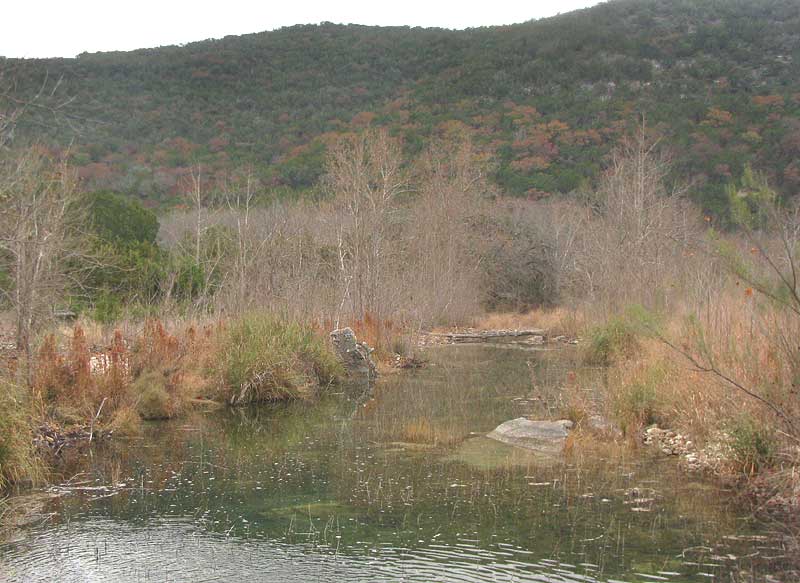
An Excerpt from Jim Conrad's
NATURALIST NEWSLETTER
January
5, 2014
Issued from the valley of the Dry Frio River in northern Uvalde County, southwestern Texas, on the southern border of the Edwards Plateau, USA

Above you can see how a stretch of our little Dry Frio River looks in winter. The leafless trees are sycamores. On the hill the green trees are Texas Liveoaks and Ashe Junipers, and the rusty colored ones are Texas Red Oaks. The tall tufts of orangish grass along the river are Bushy Bluestem and the slender stems poking up from the water are frost-killed remains of Water-willow.
The muted colors are pleasing to look at, somehow feeling just right for this time and place, and perfectly complementing a cold morning's sounds: hoarse croaks of Ravens calling from the hills; rocks knocked loose by nearby foraging bands of deer and feral pigs; water trickling over a little dam created by a fallen tree.
Now at last the days grow longer and already spring is in the air. At the Bushy Bluestems' bases green shoots are emerging, and here and there open ground is carpeted green with tiny, ground-hugging, freshly sprouted winter annuals. On sunny mornings sometimes birds briefly break into spring songs, just halfhearted snippets of what's to come, but they're spring songs nonetheless, and when you walk, sometimes you pass through currents of warm, moist air that affect you softly, like remembering a long-past romance. In fact, one yearns for more sunlight and warmth, and for more songs and blossoms, and the grand orchestration of photosynthesizing life with animals being hungry and horny and just plain happy.
These signs of spring are happening exactly when and where they should, happening like clockwork, and standing looking at the scene I think how often in my life I've let the whole spring-coming process draw me into it, wash over me, and I remember how good it felt.
But, also standing there I notice that the river is much lower than this time last year. We're in a multi-year drought here and I wonder to what extent the drought relates to the general consensus among climatologists that with global warming this part of the world will become drier, and the Chihuahuan Desert to our west will be expanding in our direction. Even if we'd get greenhouse-gas emissions under control today, they say, global warming will continue; and levels of those gases actually are increasing at a faster rate than at any time in hundreds of thousands of years.
Shaking these thoughts from my head, I focus on the fact that the landscape before me displays itself as a mosaic of patch-like communities. A riparian ecosystem with its sycamores and Bush Bluestem extends along the river, prairie grass dominates the open, cobblestone-floor floodplain, and junipers and oaks populate the slopes beyond, trees thinning and diminishing in size higher up until low scrub dominates the crest. In Nature, at every level, mosaics are more stable and sustainable than monocultures.
So, if you believe as I do that humans are part of Nature and that our societies ultimately must adhere to natural laws or else disappear, then you have to think that the monoculture-like, materialistic, consumption-oriented, greenhouse-gas spewing manner of being that has spread across the planet now similarly must fracture -- in fact is fracturing at an accelerating rate, fracturing into haves and have-nots, into mutually antagonistic religions, red states and blue states, blighted cities with islands of gentrification, vast corporate farms intermingled with organic orchards and back-to-earth communities, on and on, so in this mosaic there are patches with patches, some patches " healthily sustainable," some "destructively unsustainable," and one struggles to find the patch to identify with...
Spring is coming, the river is low, and what touches me most is the ravens' lusty but solitary croak echoing off the canyon's walls. .